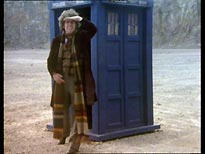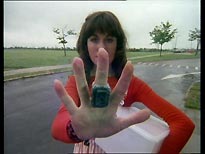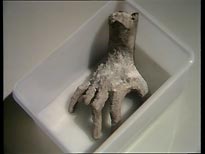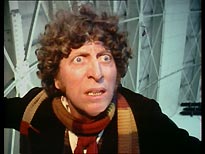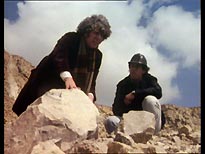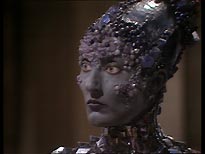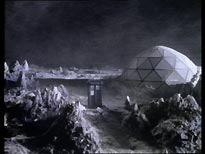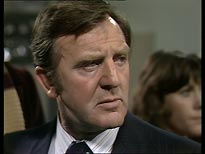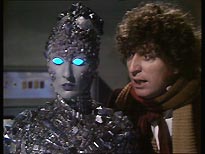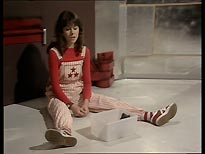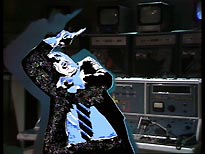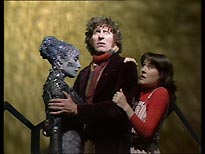|
DOCTOR WHO - THE HAND OF FEAR Region 2 (UK) Edition (also Region 4) Director: Lennie MayneStarring: Tom Baker, Elisabeth Sladen, Glyn Houston, Judith Paris
THE SERIES The Hand of Fear, the second story of Tom Baker's third season of Doctor Who, was originally broadcast in October 1976. It's a generally unremarkable adventure, with a plot that gives a science-fiction twist to elements shamelessly lifted from The Creature From The Black Lagoon (1953), Blood From The Mummy's Tomb (1971) and The Hands of Orlac (1935), amongst others. It has a certain prominence in Doctor Who history because it's the last story to feature Elisabeth Sladen as companion Sarah Jane Smith (or, at least, the last until the character was revived, firstly for a spin off special, K9 and Company, in 1981; then again - along with many other previous companions - for the 1983 anniversary special, The Five Doctors; and then again during the 2006 series of Doctor Who, in the story School Reunion). Sarah's departure accounts for only the last few minutes of the four twenty-five minute episodes, though. The rest is about an alien who arrives on Earth in the form of a fossilised hand, which has the power to possess any human being who comes into contact with it. The hand is discovered by Sarah, who takes it to a nuclear power plant, where it rejuvenates itself by absorbing radiation. The Hand of Fear was the last to be directed by the much-missed Lennie Mayne, (who had been responsible for three earlier Jon Pertwee stories, including the tenth anniversary special, The Three Doctors). It's a solid, old-fashioned Doctor Who story, made while the series was at its artistic peak. It has a charismatic villain, and some good supporting performances (including one by veteran actor Glyn Houston). The special effects are rather primitive, but the direction and cinematography are uncharacteristically good. The production makes good use of being allowed to film inside a real, cavernous nuclear facility (not something you can imagine happening now, post 9/11).
THE DVD The single-disc (DVD-9) contains all four episodes of the story, along with a commentary track, a new documentary and other bonus features. Picture quality is generally excellent. As was usual around this time, the show was recorded on 2" quad video, with 16mm film inserts for scenes shot on location. As an Earth-based story, which used one of the locations for one of its main settings (the power plant), The Hand of Fear contains an unusually high percentage of film material. As usual, we're stuck with the telecine transfers made at the time, because the original film inserts weren't kept after the production was completed. Scenes shot on film inevitably have a slightly soft-focus look to them compared to the crisp VT material. BBC film inserts are usually pretty grotty, too, because they weren't handled very carefully. Film sequences from this era are often marred by flicker, too, because of the relatively crude telecine equipment available at the time. . The new DVD version has undergone extensive grading and cleanup. Comparing the new presentation with the previous versions (the transmitted version, and the VHS release) reveals the extent of this restoration work. The film sequences on the older versions are continually flecked with dirt. Thankfully, the DVD version is virtually free of flicker. The studio material is sharp, and nicely saturated, with good colour fidelity, contrast and detail. As usual, the studio material is harshly - some would say over - lit. This often makes transitions from the location material to the studio material rather jarring (not helped by the expansiveness of the power station interiors, and the very cramped studio sets). Some sequences are affected by banding artefacts (that is to say, an image marked by horizontal stripes of slightly-different tone or texture). This is particularly evident on some of the scenes set within the power station: plain walls unfortunately make the problem much more obvious than it normally would be. According to the extensive restoration notes on the Doctor Who Restoration Team's website, the banding problem is recorded into the master tapes, and not something that could have been improved by tweaking. The relatively-poor resolution offered by the VHS format would have obscured the problem somewhat. The average bit-rate appears to be 6.17Mb/sec, and is very adaptive, with high peaks, and low dips. This is a little on the low side (it's lower than Genesis of the Daleks, and City of Death, two recent releases, for example), but it doesn't seem to have had any seriously detrimental effect on the picture quality. There's no sign of the noise-pumping or MPEG-compression artefacts that have bugged one or two of the Doctor Who DVDs. The audio for the story is standard BBC mono. The restoration notes detail the extensive work that was applied to the story's audio track, but - with all due respect to Mark Ayres' outstanding efforts - most listeners will be oblivious to most of the improvements. If you compare the old track with the restored version, the differences are often apparent, but it seems unlikely that anyone who wasn't a perfectionist would have been bothered by the flaws. The episodes and the bonus material have optional English subtitles, but there are no subtitles for the commentary track (a cost-cutting policy introduced when 2 Entertain took over the range). Navigation of the discs has been improved this time - now all the options are spelt out, rather than using somewhat-confusing symbols. Thanks for that - now can you make the tiresome intro' sequence skippable, please?!
BONUS MATERIAL Each of the four episodes is accompanied by a commentary track. The first two episodes are handled by Tom Baker, Elisabeth Sladen and Bob Baker, one of the series' co-writers. On later episodes they are joined by Judith Paris, who plays Eldrad. Producer Philip Hinchcliffe, whose contribution was recorded separately, pops up occasionally to add his own comments. The restoration notes reveal that the tracks were extensively edited and re-structured, to minimise gaps, and to accommodate Hinchcliffe's material. In the most part this is completely transparent to the listener: more fine work by Mr Ayres. Tom Baker establishes the tone of the commentary immediately, and is on good form throughout. It's evident that he recalls very little about this particular story (or any other, for that matter - "I haven't had two consecutive thoughts in seventy-two years!"), but he's worth every penny for his entertainment value alone ("Look at my pikey sideburns!"). There are even times when Tom deliberately supplies disinformation, in service of an amusing anecdote. Thankfully, Elisabeth Sladen keeps things grounded in reality. Bob Baker explains some of the background to the story (but not in as much detail as the Info Text does - more on those later), but he's rather vague on specifics (possibly because it was all a very long time ago, but more probably because script editor Robert Holmes was responsible for much of the nuts and bolts of the script). Tom Baker is more forthcoming here than he was on the Genesis of the Daleks commentary track, and the result is a free-flowing, very entertaining commentary track that's one of the best of the range. The disc offers the option to view Info Text subtitles while the story plays. Written by Dr Martin Wiggins, these offer lots of information about the story's origins (it began as a story about a race of silicon-based aliens, the Omegans, and would have featured Brigadier Lethbridge-Stewart - as detailed in Doctor Who Magazine issue 302), as well as plenty of trivia about the production itself, including the safety procedures and regulations that had to be followed by the team when they were shooting inside the power station and in the studio. In the process a few myths which have crept into generally-reliable reference works are debunked. The story is supported by a new fifty-minute documentary, titled Changing Time - Living and Leaving Doctor Who, which examines a three year period during which the entire Doctor Who team - behind and in front of the camera - had changed. It features interviews with Tom Baker, Elisabeth Sladen, Rex Robinson (who was a member of Lennie Mayne's repertory company of actors), Bob Baker, Philip Hinchcliffe, actor Stephen Thorne (who appeared in four Doctor Who stories), former producer Barry Letts (who explains the casting procedure for the two assistants he cast), former writer and script-editor Terrance Dicks, and special effects designer Colin Mapson. They offer their own interesting perspectives on the era, and on The Hand of Fear in particular. The documentary nicely complements the commentary track (between them, they feature the story's two main guest cast members). Aside from one curious quirk (having other contributors appear in the background of other people's interviews), the documentary is commendably gimmick-free, and very engaging. It's presented in 16:9 format. Clips within the documentary that were originally 4:3 are treated very sympathetically. Continuities collects together a minute-and-a-half's worth of continuity announcements from the top and tail of the episodes' original transmission. Nothing too exciting, sadly. Perhaps material as peripheral as this be better hidden as an Easter Egg? Swap Shop is a ten-minute extract from Tom Baker and Elisabeth Sladen's appearance on the legendary Saturday morning children's magazine show, originally broadcast on 2/10/76 (the very first edition of Swap Shop, in fact). Since the programme wasn't kept by the BBC, the recording has been rescued from a worse-for-wear Philips 1500 domestic recording, which required extensive restoration. This is a very welcome addition to the disc, even if, as suggested in the Restoration Team's notes, it is an edited version of the complete segment (there wasn't time, or the budget, to restore the entire clip). They've done an amazing job of restoring it, judging by the "before" screen grab on their site. It's a very interesting clip: Baker seems a little nervous until engaged by the children on the phone. Heisn't even able to name his predecessors without a little prompting, and the atmosphere is rather awkward. Hopefully the rest of the clip can be cleaned up later, so that it can be released in its entirely, on another DVD. The Photo Gallery (5m) gathers together dozens of stills taken during production, showing them slideshow-fashion, accompanied by a suite of sound effects from the story. As usual, there are a few rare images, including Design Department images of some of the sets. There are two PDF files on the disc, offering the Radio Times Billings (including the large billing for Swap Shop), and the complete 1977 Doctor Who annual. The 1977 annual is pretty worthless, with some truly horrible artwork, and some weak filler material, but having it on the DVD is certainly worthwhile. At this rate it won't be long before all the annuals will have been offered this way. A word, too, on the PDF presentation, which is first rate. In less skilled hands you'd be lucky if you got some crappy low-resolution scans, blighted by screening artefacts. Instead what you have is a labour of love, and a fine substitute for actually owning a copy of the annual itself (this isn't such an issue with the Baker annuals, which are easily and cheaply obtainable, but it will be a godsend when the rest of the Hartnell and Troughton annuals are offered). Finally, there's a short Easter Egg, which can be found on the main menu screen (highlight the series' logo). It's a very short clip, which looks like its come from a similar source to the Swap Shop clip. It's an extract from a longer piece, but this is all that survives.
SUMMARY The story may not be anything special, but it does contain a landmark scene; one that will have special resonance for fans of the David Tennant series. The bonus materials elevate the disc to "must buy" status. The commentary is very entertaining, and provides good value for money. The Changing Time documentary is one of the best so far, offering a good overview of a turbulent time in the show's history. The Info Text is rewarding, and offers lots of interesting trivia. The other bits and pieces make the disc a fully-rounded package, and should thrill hard-core collectors. The Hand of Fear is another excellent disc, proving once again that the Restoration Team can make silk purses out of any old tat! |



